We know that plastic waste is an issue for the environment, our health and the economy but the question may rightly be asked, what can we as individuals do about it?
If you have read a bit of my stuff, you will be aware that one of my favourite quotes is by Edwards Demming: “What you don’t measure, you don’t control”. So having decided that plastic waste is an issue that we as individuals can have an impact on, the first thing to do is to work out how big the problem is for us personally.
One method that I have used before (and written about) is the Waste Audit. From my previous article – “To conduct your waste audit, every week for a month or so before you put your waste out for collection (recyclable and non-recyclable) get hold of a large plastic groundsheet or shower curtain and spread it out on your lawn or other open area where you have a bit of space. Put on a pair of thick rubber gloves and separate the solid waste into categories, (EG paper, glass, plastic, steel, clothing, chemicals etc) weigh each category using kitchen scales for the smaller amounts and bathroom scales for any large amount and enter the weight into the waste audit form.”
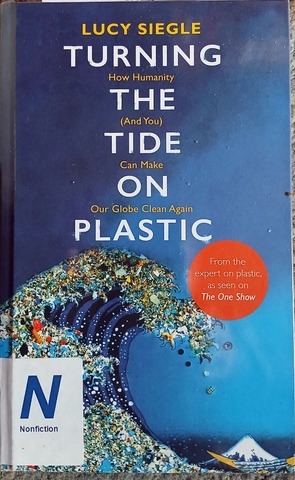
Just recently I came across another method, specifically focussed on plastic waste, that I put into practice for the month of April (2025) called the Plastic Waste Diary. I found the idea in the book ‘Turning the Tide on Plastic’ by Lucy Siegle. She suggests you set up a grid on paper or on a computer and then set aside all plastic waste that you produce and enter it onto the diary before disposing of it. I had some issues with the design and made a couple of changes so that it worked for me. Below is what I came up with –
This is the original design from the book:
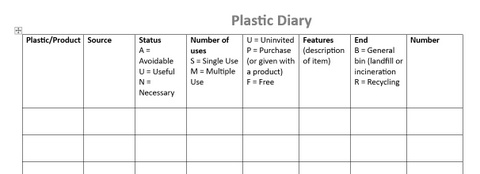
This is my modified design
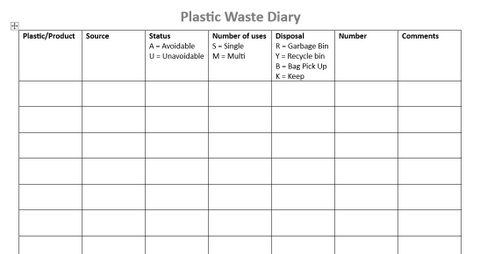
In some ways it is more detailed that the Waste audit, and is set around the numbers of pieces of plastic rather than weight, which to help identify and analyse the large numbers of small plastic bits and pieces makes a lot of sense to me! Copies of the plastic waste diary can be downloaded here.
What is most important, I believe, is the concept of putting together and using the plastic waste diary. Feel free to check out the modified version that I put together because it made sense to me, but don’t take it as cast in stone. Modify it so that it makes sense to you and your situation in the same way that I took hers and modified so that it made sense, and was useful, to me!
My modified plastic waste diary has seven columns –
Column 1: plastic/product – I use this to describe the plastic, the product that is associated with and what function the plastic was performing. Eg soap packaging bag, nut and bolt packaging or cake surround.
Column 2: Source - This column I used to record where the plastic had been purchased from and I eventually came up with such classifications as ‘Supermarket’, ‘Greengrocer’ ,‘hardware’ etc.
Column 3: Status – The original author came up with three possibilities here: A = Avoidable, U = Useful and N = Necessary, although to me she does not really define or explain very well what each one means. For my money, the important distinction was, if the plastic waste was avoidable (by buying in bulk, making at home, using packaging free stores or other strategies to be discussed later) or was it unavoidable like medication blister packs because we need the medication, and it is unlikely we will return to the days when all our drugs came in glass bottles. Hence I have reduced the options to just two: A = Avoidable or U = Unavoidable.
Most of the items in the diary were avoidable but some would be too much hassle to replace. I found items like medication blister packs to be unavoidable because we need the medication, and it is unlikely we will see a return to the days when all our drugs came in glass bottles.
Column 4: Number of uses – this one has two possibilities S = Single and M = Multi. I struggled with this one also, stupid as it sounds! Is a bag of, say, bread which will be used over several days single or multiuse? I came to the conclusion that most of the plastic we had coming to our place was single use in that it was not refilled or repurposed but used until empty then discarded.
Column 5: Disposal – What was the ultimate fate of the plastic we had brought into our home? I developed four categories which made sense for how we do things around here, which are: R (red bin) = Garbage bin; Y (Yellow bin) = Recycle bin; B (Bag Pick up) RecycleSmart monthly soft plastic and blister pack pick up. Last one is K (Keep) because there are some plastic containers that we find useful and keep them for reuse rather than recycling or dumping.
Column 6: Number – this is simply the number of items in each entry. Initially I added a separate entry for every item but quickly worked out that when the items were the same eg chip packet, bread bag or frozen food bag it was easier just to add on to a previous entry rather than create a new entry with everything the same.
Column 7: Comments – This column I reserved for anything else I wanted to put in but practically it was mostly comments about the type of plastic and if there was an identification number.
The process
This was pretty simple. After drawing up the diary on in Word on my computer, I set out a large shopping bag in the back room near the recycling bag, and any plastic waste was put directly into it. Twice a week I would take it up to the office, then empty it one piece at a time as I recorded it in the diary. I then removed each piece to its final destination (recycle, bag pick up etc.) and reset the bag in position. Simple as that!
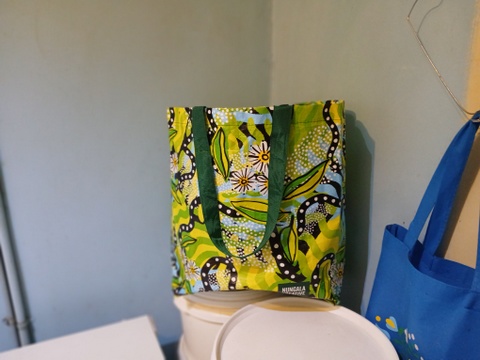
The plastic waste bag!
We decided that the diary still was in force when we went out for the day so that if we, for example, got takeaway food that had had a proportion of plastic while we were out, we had to take the plastic bits home with us, or at least make notes so that the pieces could be added to the diary at a later stage.
A side effect of the diary process is that it helps you focus on the plastic waste you are generating and gets you looking at recycling numbers to see what waste is recyclable where we are, or if it is not recyclable. This caused us to started looking more carefully at what we were buying. We didn’t make any changes during the time we were writing the Diary because I wanted a true reflection of how much plastic waste we were generating.
The Analysis (how did we do?)
To give some context, in her book “Turning the Tide on Plastic”, Lucy Siegle states that for a two-person family in the UK the number of items of plastic waste generated over a four week period would be “running at between 300 and 1000 items”. A pretty wide variation, but it is what it is, I guess! Our total was 142 pieces of plastic waste generated for the month of April, or less than half the smallest UK total.
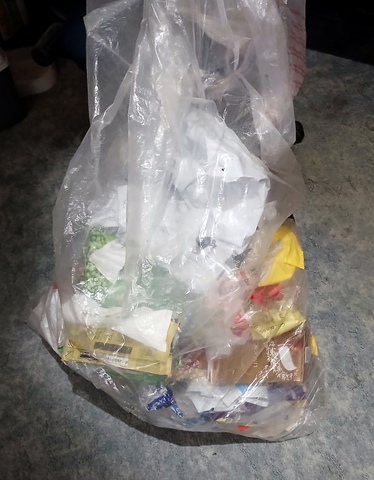
Some of the plastic waste we collected in April 2025
To be fair, we had already been through a waste reduction process previously, but I was still happy with the waste diary result, although I am sure we could do better. How to do better? First analyse the results to give us a better picture of what we were dealing with.
There were some ‘one-off’ purchases that included plastic packaging of some description, but there are likely to be one-off purchases in any given month, so the reduction strategy can be twofold – consider plastic waste free options (where they exist) before making a new purchase and look at options to reduce the plastic packaging/waste content of regular purchases.
This is what we got:
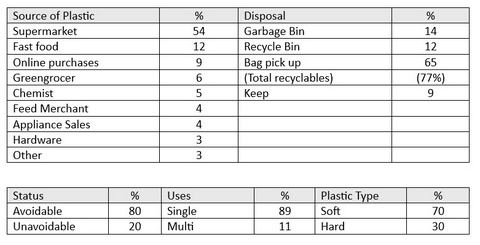
So, Where to from Here?
For us, the first thing is to set a target, then work out a plan to achieve the target, then program in another Plastic Waste Diary for some time in the future to see how we are going at achieving it. Here is my plan –
The Target: Reduce the plastic waste produced by 42 pieces, or in other words, reduce our plastic waste production by 30%.
Ideas for Plastic Waste Reduction
Some possibilities of how we can reduce our plastic waste are covered below:
Possibilities for plastic reduction Reduction in pieces
Replace plastic packaged ice blocks with alternative 18
Buy chocolate from packaging free shop only 15
Stop buying fruit an veg in plastic bags/wrap 9
Bake our own bread products (buns, muffins etc) 8
Replace groceries in plastic bottles with glass 7
Buy unpackage pies or make our own 4
Buy sanitiser in bulk 3
Refuse cakes with plastic surround 2
Total Piece Reduction 66
There are also a number of changes that would deliver single piece reduction of plastic waste figures such as buying soy sauce in smaller glass bottles or buying soap in bulk plastic free. Implementing all these totally would deliver us the target without difficulty, but things may not be as easy as they appear as we go forward with the plan.
We will be looking towards conducting a confirmatory Plastic Waste audit in October 2025 to see how well (or otherwise!) we have done.
Wish us luck!


